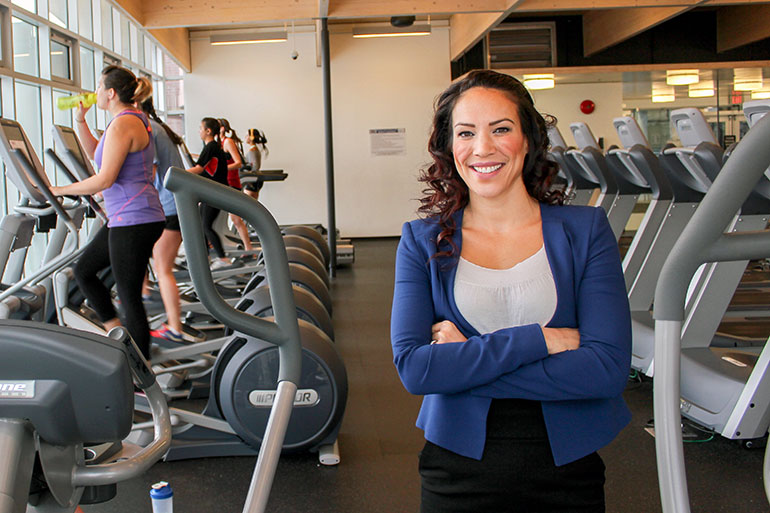
UBC Okanagan associate professor Mary Jung
Researchers examine BC’s daily physical activity guidelines
With back to school, there are many things on a parent’s mind. Beyond packing lunches, paying fees, and sharpening pencils, should parents worry about how active their kids are?
With the provincially mandated daily physical activity guidelines, you’d think not. But new research from UBC’s Okanagan campus, says the guidelines only work if teachers provide more time for children to be active during class time.
Associate Professor Mary Jung, who teaches in the School of Health and Exercise Sciences, recently led a study examining the effectiveness of the daily physical activity (DPA) in elementary schools.
“In Canada, it is recommended that children participate in a minimum of 60 minutes of moderate-to-vigorous physical activity every day,” says Jung. “However, the majority of children are failing to meet these guidelines.”
Childhood physical inactivity is a health risk factor for several conditions including obesity, which can lead to other health issues as an adult, she explains. And while the BC government introduced DPA guidelines into the school system in 2008, her recent study finds that not all students get the required amount of activity for a variety of reasons—including how teachers implement the guidelines.
UBC master’s student Katie Weatherson, who led the study, says this is the first research that she’s aware of that explores the effectiveness of BC’s DPA policy from the student perspective. Because elementary students are expected to have moderate to vigorous activity levels to help them achieve optimal health, the study uses 30 minutes of moderate-to-vigorous activity as the daily requirement.
“Unfortunately, the policy does not mandate how schools or teachers must implement DPA during the school day,” says Weatherson. “As a result, teachers’ DPA implementation approach may vary and have a diverse effect on student’s PA levels.”
For the study, Weatherson interviewed 12 elementary teachers from different schools, who taught Grades four to six, while 10 students from each teacher were randomly selected to wear accelerometers for a school week, and other students were given a pedometer to wear.
Each teacher reported that their respective school did not provide instructions as to how they should implement DPA during the instructional and non-instructional portion of the school day. The teachers also said they had the autonomy to implement the policy as they saw fit. As a result, some teachers prepared organized DPA opportunities in class, including running, stretching and aerobic activities, while others offered extra free time to play. And a few teachers did not provide additional DPA opportunities beyond lunch and recess breaks.
Weatherson notes the teacher’s implementation strategy regarding DPA made a significant difference in the activity the students actually had each day.
“Teachers who provide any opportunity for children to move during class time outside of scheduled recess and lunch breaks will promote fulfilment of the guidelines,” she says. “Of course, providing activities that children enjoy will create more buy-in and improve participation.”
The study recommends that in addition to mandating daily guidelines, the government and school administrators provide better support through ongoing funding and training for teachers so they can implement activity into the classroom.
“It is important that governing bodies and school districts help foster an environment conducive to helping teachers provide physical activity opportunities and student involvement in these opportunities.”
The study, published recently in Translational Behavioral Medicine, received partial funding from the Canadian Institutes of Health Research and the Michael Smith Foundation for Health Research.
About UBC's Okanagan campus
UBC’s Okanagan campus is an innovative hub for research and learning in the heart of British Columbia’s stunning Okanagan Valley. Ranked among the top 20 public universities in the world, UBC is home to bold thinking and discoveries that make a difference. Established in 2005, the Okanagan campus combines a globally recognized UBC education with a tight-knit and entrepreneurial community that welcomes students and faculty from around the world. For more visit ok.ubc.ca.
 Police watchdog called in
Police watchdog called in Mayor calls 'BS' on list
Mayor calls 'BS' on list U.S. authorities find bodies
U.S. authorities find bodies Premier stands by pick
Premier stands by pick Canada's most-wanted list
Canada's most-wanted list Sask. will still get rebates
Sask. will still get rebates Santos ends comeback bid
Santos ends comeback bid Douglas C-54 plane crashes
Douglas C-54 plane crashes Trump's 'eyes and ears'
Trump's 'eyes and ears' US TikTok ban sent to Biden
US TikTok ban sent to Biden Phish fans enter the Sphere
Phish fans enter the Sphere CN Rail profits fall
CN Rail profits fall  Warriors snakebitten in loss
Warriors snakebitten in loss Iginla off to Europe
Iginla off to Europe Rockets ink prospect
Rockets ink prospect Alleged Tupac killer in court
Alleged Tupac killer in court Lawsuit accuses Megan
Lawsuit accuses Megan Bam Margera’s tour axed
Bam Margera’s tour axed




